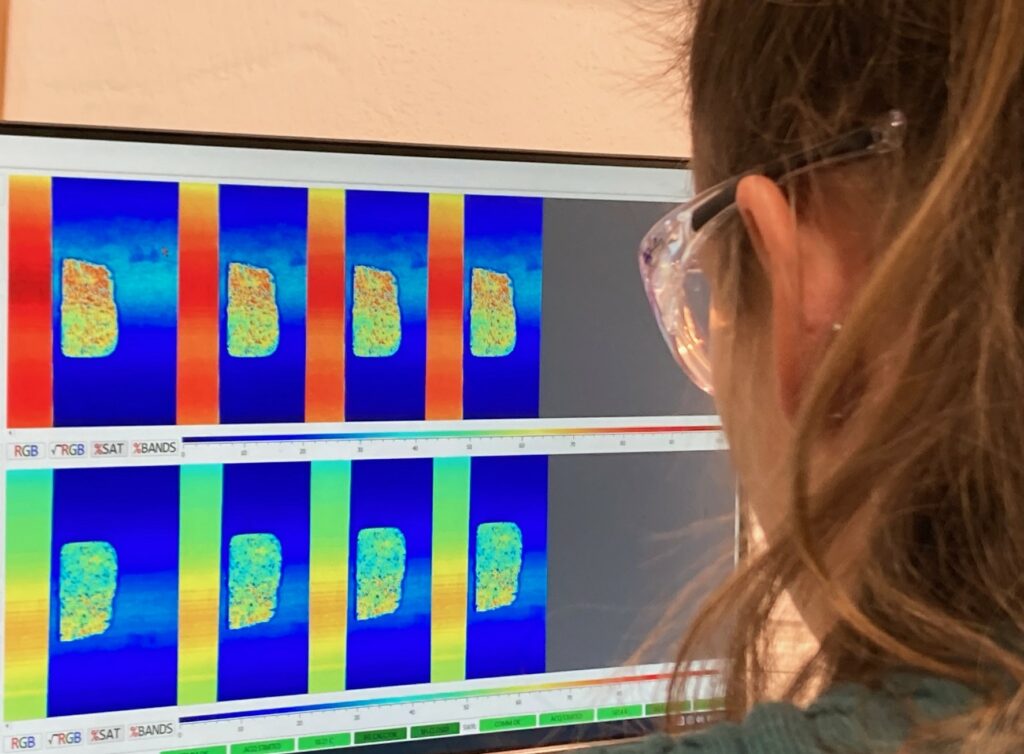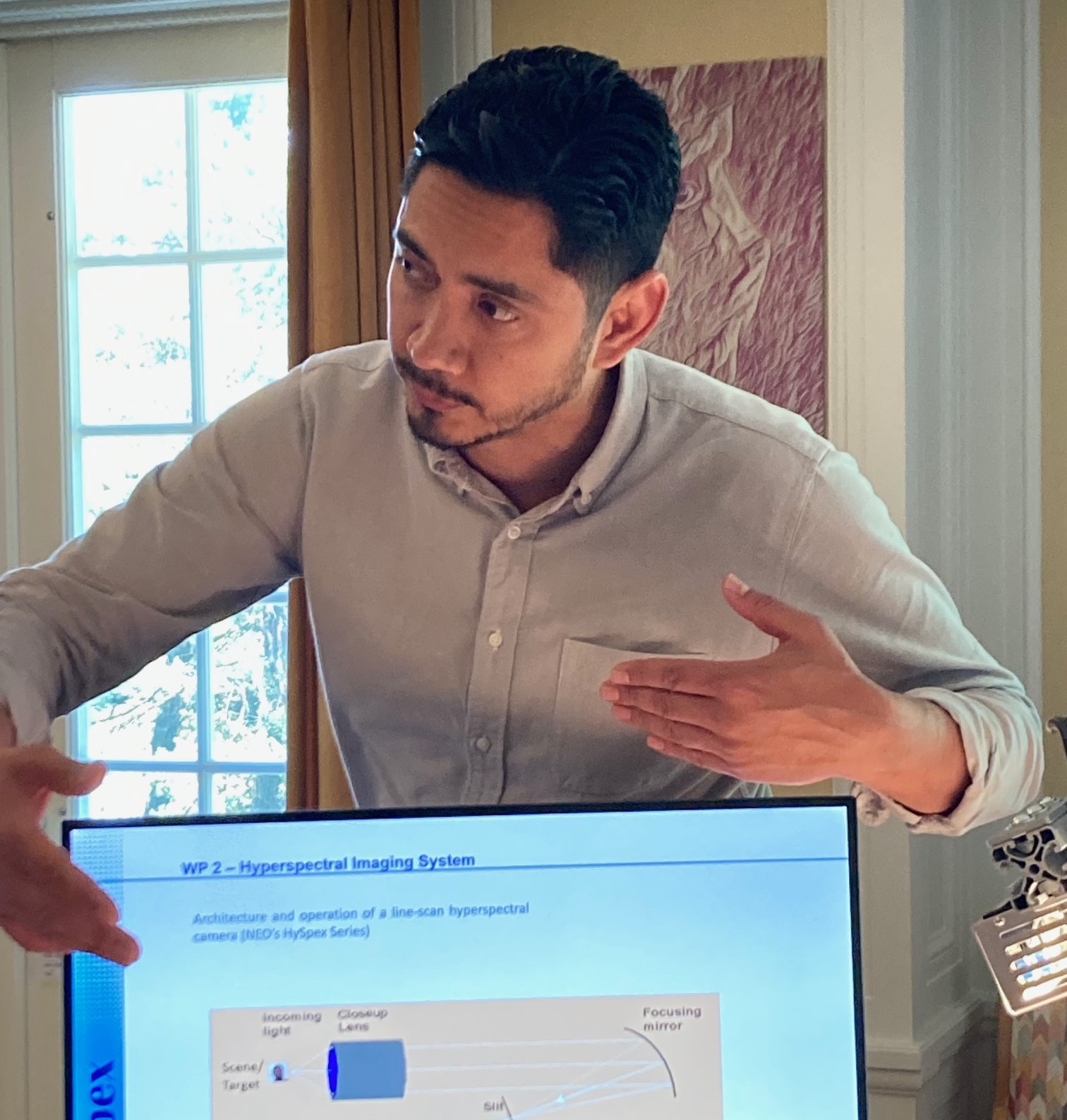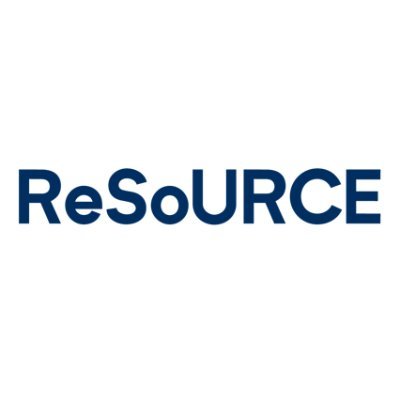NEO visit in Leoben in October 2023

Julio Hernandez and Dennis Adamek from Norsk Elektro Optikk, Oslo (NO) came to visit RHI Magnesitas’ researchers in Leoben (AT) to help install a complete hyperspectral imaging setup and train the colleagues in Leoben in how to obtain high quality hyperspectral imagery.
As you might recall from earlier blogposts (see for example the blogpost from Friederike Koerting: Our Samples in the Light of Science), hyperspectral imaging is a technique that can detect spectral information with high resolution (typically several hundreds of narrow, contiguous spectral bands) for each pixel in an image, allowing for the identification of specific materials or substances based on their unique spectral signatures. Hyperspectral images can reveal intricate details about the composition and characteristics of the imaged objects or scenes.
The system that was installed in Leoben carries both the HySpex VNIR-1800 and the SWIR-384 cameras, which, when combined, allow to record spectral information from 400-2500nm, covering the visible, near infrared and short-wave infrared spectral regions. Samples are illuminated by two strong halogen lamps that provide light across the complete spectral range. The spectral distribution of the light reflected from the samples depends on the chemical characteristics of the material. As such, it contains information on the composition of the samples and can be used to identify specific properties. The cameras used for collecting this reflected signal are line-scanner imaging spectrometers capable of orderly diffracting a broadband input light signal and map it onto a digital sensor. Spatial and spectral information is acquired simultaneously from a linear section of the imaging area, and either movement of the camera with respect to the samples or vice versa provides the second spatial dimension for forming a 2D image with spectral information stored in the third dimension of a 3D digital array.
With this lab setup the researchers at RHI Magnesita will be able to scan lots of samples during the next months and collect large amounts of data on the different kinds of refractory materials investigated in this project. On a controlled data set also reference measurements like XRF or Micro-XRF will be performed that will serve as a ground truth to validate the hyperspectral data. Subsequently we will use all these measurements to train classification and quantification models that will be able to deliver information like brick type, composition or potential contamination of previously unknown samples, enabling automation of the refractory recycling process the ReSoURCE project is aiming at.
During the two days of this visit the team had fruitful discussions about refractory material characteristics, hyperspectral imaging best practices and strategies to distinguish certain refractory material types based on material-specific spectral features. Time allowed to start scanning and investigating selected used refractory brick material samples from both cement rotary kilns and steel casting ladles. The samples were prepared in form of brick slices and irregular breakout material chunks to account for different sample geometries. The high carbon content and thus dark color of the steel casting ladle bricks were challenging to scan this time as only a white reference panel was available for testing, which quickly saturates at camera integration times that are necessary to obtain enough reflected light from these samples. Reference panels are used to calibrate the hyperspectral images to true reflectance to provide absolute measurements and inter-comparability between different hyperspectral systems or other spectroscopic instruments. Within the next week the RHI Magnesita team will get suitable darker reference panels as well to account for various brightness of the investigated refractory samples. The higher brightness of the cement rotary kiln brick samples, however, made it easy to obtain high quality images. An interesting feature of these kinds of bricks is the type of spinel included in the brick matrix. The spinel material is not susceptible to infiltration and contamination during the burning processes, so an interesting experiment will be to see if the spinel type can be used as a marker in the recycling decision process.
We are looking forward to further discussions as soon as more data is available and hope that the experiments performed by the colleagues at RHI Magnesita will clarify brick sorting criteria and help build reliable and accurate models to improve refractory material recycling and reach the goals of the ReSoURCE project.
Also, our project partners from Montan-University Leoben (AT) are invited to take part in the experiments and get hands-on experience with the system now installed in Leoben.

Author’s Portrait
Julio Hernandez
Julio Hernandez, MSc, is a senior research scientist at Norsk Elektro Optikk AS with over 15 years of experience in the field of hyperspectral imaging. Julio has worked developing scientific-grade hyperspectral cameras and data acquisition systems for a variety of applications within remote sensing, defense, industry and biomedical research. He is currently Manager of the Hyperspectral Applications department at HySpex, focused on developing customized solutions for end-users and promoting the adoption of hyperspectral technologies in new markets. Julio studied Physics at the Autonomous National University of Mexico (Mexico) and Nanotechnology at Chalmers University of Technology (Sweden) with specialization in quantum information systems.

Author’s Portrait
Dennis Adamek
Dennis Adamek, MSc, is an application specialist at HySpex/Norsk Elektro Optikk AS, focusing on enabling hyperspectral imaging technology for industrial applications. Within the ReSoURCE project he is supporting experiment design, hyperspectral system installations and hyperspectral data analysis. He holds a master’s degree in physics from Friedrich-Schiller University Jena, Germany, with a specialization in optics, photonics and spectroscopic data analysis.
